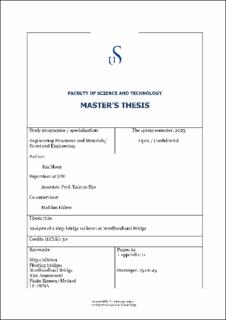| dc.description.abstract | The Nordhordland Bridge, a floating bridge located in Norway, spans a length of 1246 meters and was completed in 1994. Over the years, the bridge has experienced two instances of ship collisions so far, resulting in minor damage. Considering the advancements in ship collision risk assessment, ship impact analysis, and changes in ship traffic, a reassessment of the original design requirements for the bridge is undertaken. The main objective of this research is to determine if the prestressed reinforced concrete pontoons of the bridge have the strength to withstand accidental loading from a ship collision. As ship collisions pose a significant risk to the structural integrity of floating bridges, it is important to state the capacity of the pontoons. The impact of a ship collision can cause severe damage to the pontoons, leading further to a potential collapse of the bridge.
A structural impact analysis is carried out using the software LS-DYNA to assess whether the pontoons of the bridge can endure the previously determined impact load level. Five different scenarios are simulated in the analysis. A head-on impact in the centre of the pontoon, with and without a strengthening sheet of Carbon Fibre Reinforced Polymer (CFRP) of different thicknesses. A head-on impact off the centre of the pontoon, towards one of the internal concrete walls in the pontoon and a glancing blow will be analysed.
The results of the analysis indicate that the current pontoon design does not possess sufficient structural capacity to withstand the loads from a head-on ship impact, which amounts to approximately 25 MJ of impact energy. Additionally, it is evident that the extent of damage varies considerably depending on the specific location of the ship's bow impact with the pontoon. The results with the CFRP sheet strengthening the pontoon wall indicate a positive trend, suggesting that the approach employed may have a beneficial effect on the capacity.
The findings from the analysis reveal that the pontoons, which form the foundation of the bridge, are particularly vulnerable to ship impacts and do not possess adequate capacity to meet present-day requirements. | |
